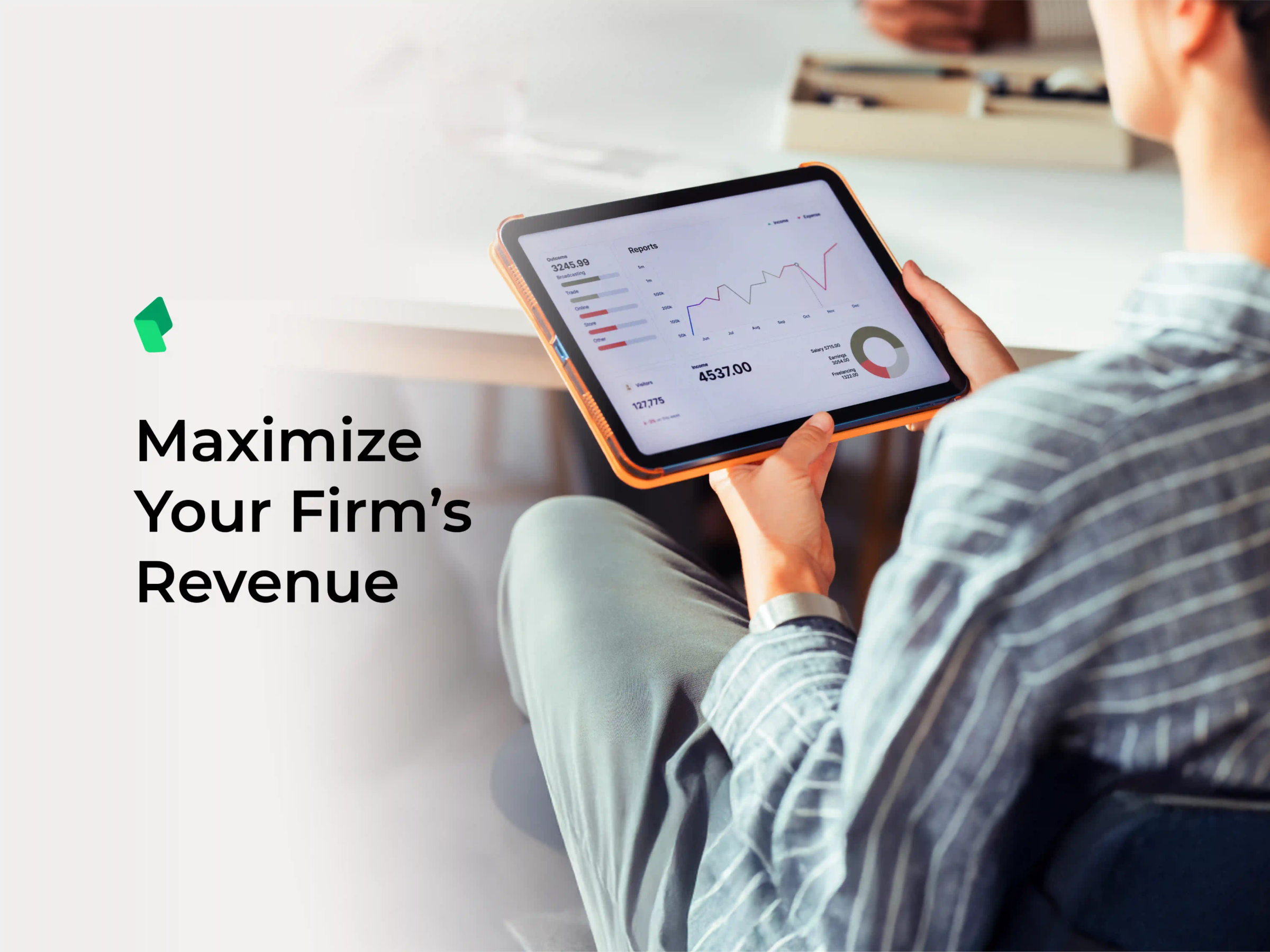You can engineer greatness for your law firm. Even better, the formula for success is more straightforward than you might realize. Greatness is found in managing details—because minute-by-minute efficiencies can combine into a finely tuned and scalable business.
Having worked closely alongside personal injury lawyers around the country for years, we at CASEpeer understand what makes a great firm. We've helped successful law firms gain command of operational details so they can achieve profitability and scale.
This law firm profitability guide incorporates the best practices of the greatest firms. Read on to learn about key metrics, profitability analysis, and strategies that benefit the firm's bottom line.
Understanding Law Firm Profitability
Profitability analysis is a critical piece of running a law firm. Too many new firms focus their efforts on revenue alone without minding the expense side of the equation. And while rising revenue is an important component of growth, it's only sustainable if the firm is profitable.
The basic profit formula is total revenues less total expenses. You can additionally measure the efficiency of expenses with margin calculations. Net profit margin, for example, is net profits divided by total revenue, then multiplied by 100. This percentage quantifies the profits earned from each $1 of revenue produced.
If revenues don't cover expenses, the firm eventually runs out of funding. On the other hand, a firm with rising profits and expanding profit margins generates more capital for growth initiatives.
Key Metrics to Measure the Profitability of a Law Firm
Net profits and net profit margin are high-level profitability metrics. You can compare these numbers to the firm's historic performance to see profit improvements or declines. You can also compare net profit margin to industry averages to understand how the firm performs vs. its peers.
The analysis doesn't end when you quantify and compare the firm's profitability, however. The next step is to find out what's behind those numbers. To do that, you'll track and review additional law firm profitability metrics. Specifically, you'll want to quantify performance on revenue, administrative work, marketing, and client services.
The six key KPIs for law firms will help explain your law firm's profitability trends and reveal operational strengths and weaknesses.
Revenue per Lawyer (RPL)
RPL is the average revenue generated by each lawyer on staff. The calculation is revenue divided by the number of lawyers employed during a given timeframe.
RPL quantifies the firm's revenue efficiency. A high RPL is the product of an efficient team of lawyers combined with a competitive fee structure and low write-offs.
Profit per Partner (PPP)
PPP averages the profit generated by each equity partner in the firm. To calculate PPP, divide the firm's net profit by the number of equity partners. The formula will be different if some equity partners are responsible for higher percentages of profits.
A high PPP signifies a productive business model. It also attracts better talent and promotes client trust.
Utilization Rate
Utilization rate is the percentage of employees' time that's used for billable work. The utilization rate calculation is the number of hours billed divided by available work hours. For example, a solo lawyer who bills 12 hours in a week has a utilization rate of 12/40 or 30%.
The National Law Review reports an average utilization rate for lawyers of 27% to 37%. A low utilization rate means billable employees are spending too much time on administrative tasks. It's also possible they're not tracking billable hours effectively. Poorly utilized legal teams will struggle to generate enough revenue to meet profitability goals.
Realization Rate
Realization rate is what the firm billed vs. actual hours worked at standard rates. If the firm spends 100 hours working a case but bills 80 hours, the realization rate is 80%. Discounts, write-offs, and poorly estimated flat fees can contribute to lower realization rates.
Low realization rates point to lost revenue opportunities, which reduces profitability.
Client Acquisition Cost (CAC)
CAC is the average amount the firm spends on securing one new client. To calculate CAC, divide total marketing spend in a period by the number of new clients gained. Marketing spend includes advertising costs plus any expenses associated with the firm's website, networking events, email marketing, and social media.
A high CAC is problematic for two reasons. One, it strains law firm profitability. At a basic level, the firm must earn more from clients than it spends to acquire those clients. And two, a high CAC indicates marketing inefficiencies. In other words, the firm may be spending on efforts that aren't effective in bringing in the volume of clients needed.
Client Retention Rate
Client retention rate is the percentage of contracted clients who stay with the firm. To quantify that percentage, subtract the number of acquired clients during a period from the total number of clients at the end of that period. Then divide that result by the number of clients at the start of the period.
A high retention rate improves profitability by reducing the firm's dependence on costly marketing. Retention rate trends also provide critical feedback on customer satisfaction.
How to Perform a Law Firm Profitability Analysis
The law firm profitability metrics above are useful for quick check-ins on profitability. You may want to incorporate them into your financial and operational reporting, so you have an easy visual snapshot of how the firm is performing.
Additionally, you'll want to conduct a deeper profitability analysis periodically. The process for conducting a law firm profitability analysis is outlined in seven steps below.
Gather Data
First, gather financial and non-financial data. This should be straightforward if you have reliable information available. If the firm's documentation is scattered and unorganized, you may need a separate effort to improve data quality.
Use trends in your key metrics to guide your data collection. For example, if you see the firm's retention rate dropping slowly over time, pull together any information you have on client satisfaction. That could include client satisfaction scores, online reviews, and specific client feedback noted in case files or elsewhere.
In some cases, the "data" you gather may come in the form of interviews. Say, for example, that the firm's utilization rate is trending down. If timekeeping entries don't explain what's happening, consider interviewing your staff. Or, ask them to start logging every activity, billable or not, so you can understand which non-billable tasks are most time-consuming.
Break Down Revenue Sources
Next, categorize the firm's revenue. You can analyze revenue by case type or the source of the client relationship, such as advertising or referral. Start with whatever breakdown makes sense for your firm. If you're still left asking questions, try categorizing the revenue differently.
Analyze Costs
Reviewing costs by category and how they're trending over time can quickly highlight inefficiencies. Overhead, technology, and personnel costs may be the largest line items. Make sure each of those expenses is producing sufficient value.
Your technology, for example, should create efficiencies for the firm and its clients. This might come in the form of automated workflows that reduce non-billablenon billable hours or online payments that streamline account management for clients.
Assess Time Tracking and Utilization
Healthy utilization is a priority for every law firm. Assuming the firm has enough work to keep lawyers busy, insufficient billing can come from poor timekeeping or ineffective job structure. To restore a healthy utilization rate, you must first understand which problem to solve.
If lawyers are not fully capturing their billable tasks, a semi-automated timekeeping system can help. If lawyers are bogged down with non- billable work, you'll need a more comprehensive solution. You might deploy technology to create efficiencies and transition some tasks to lower-paid team members, for example.
Evaluate Client Profitability
Law firms are in the business of representing clients, and that business should generate profits. Reviewing profitability by client or case type can pinpoint problems that would otherwise go unnoticed. You might learn, for example, that one client type is growing in terms of revenue but has the worst profit margins. Or you might see that referred clients are your most profitable group, but they represent only a small percentage of your revenue.
These insights can help optimize marketing efforts. They can also reveal areas where fee increases are necessary.
Measure Productivity and Efficiency
There are many ways to measure law firm productivity and efficiency. Your analysis up to this point should direct you to areas that require further explanation.
If the firm's realization rate is poor, for example, you'll want to identify why. Perhaps a flat fee service needs to be repriced. Or clients aren't prepared to fund the total cost of their representation.
You might also uncover inefficiencies in administrative tasks that can be addressed with technology. Or, you might find productivity challenges that can be helped with employee training.
Benchmark Performance
Lastly, benchmarking the firm's KPI performance against industry averages can reveal issues and improvement opportunities. Peer averages provide important context to help you understand whether your firm's RPL, PPL, utilization rate, etc., are good or bad.
Strategies to Improve Law Firm Productivity
A law firm's profitability analysis should highlight the most pressing operational problems. Now, let's tackle how to improve law firm profitability.
Solutions for law firm profitability issues generally fall into one of three buckets: optimizing revenue streams, enhancing operational efficiency, and improving client acquisition and retention.
Optimize Law Firm Revenue Streams
Strategic moves to optimize law firm revenue include:
Diversifying services: Consider whether you can easily expand the services you offer. If you must add expertise to your team, consider the size of the market opportunity to determine if the added expense is worth it.
Implement value-based pricing strategies: This involves raising fees on services that clients perceive as high-value. Instead of billing hourly for business contract reviews, for example, you might charge a higher flat fee.
Ensuring high-value cases don't slip through the cracks: If the firm doesn't have a process for tracking prospects and high-value issues from current clients, implement one today. A lead management system that prompts regular follow-up can often pay for itself with new business.
Enhance Operational Efficiency
There are many ways to improve a law firm's operational efficiency, but the right technology can deliver results quickly. Effective legal software can reclaim valuable hours by automating administrative tasks.
Longer-term, also consider whether you have the right expertise on your team. You may need to bring on an administrator or a marketing specialist so lawyers can remain focused on their clients.
Improve Client Acquisition and Retention
If the firm is spending too much to secure new clients, it's time to lower client acquisition costs and improve client retention. Start by identifying the firm's most efficient marketing and business development efforts. Minimize spending on campaigns that aren't productive. Then take steps to measure and improve client satisfaction.
Lead-tracking and other CASEpeer data analytics are a great starting point for measuring marketing efficiency. Additionally, client surveys can provide critical feedback on how clients view the firm and how client-facing staff members can improve.
Drive Meaningful Growth with CASEpeer
Find scalable profitability for your law firm by managing the details. CASEpeer can help by organizing client and operational data, streamlining workflows, and freeing lawyers from excessive non-billable tasks. With CASEpeer, you can drive meaningful growth and achieve greatness—for your clients, your team, and yourself. Book a demo today.
About the author

CASEpeer Team
